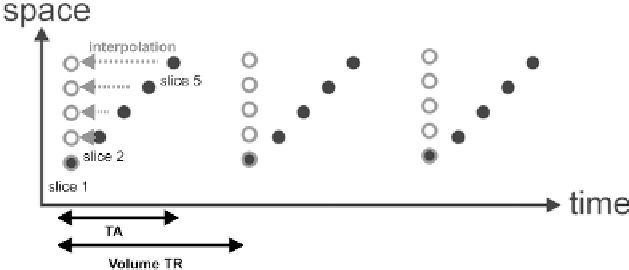Image Processing Reference
In-Depth Information
spaces, and is essential to compare the results between different subjects or
different groups of subjects and to facilitate communication among laboratories
(see
Reference 4
). fMRI, however, as opposed to PET, also allows for the analysis
of single-subject data. Additional steps can thus be included to display the relation
between functional information and individual brain anatomy with more efficacy
compared to the conventional serial 2-D slice representation (see
Reference 7
).
15.2
PREPROCESSING OF FUNCTIONAL
TIME SERIES
15.2.1
S
T
C
LICE
IMING
ORRECTION
With 2-D EPI sequences conventionally used to collect the functional time series,
volumes are formed by collecting one slice at a time. This implies that different
parts of the brain are measured at slightly different moments in time, and that a
functional volume cannot be considered an “instantaneous” temporal sample
during which the brain activity is observed simultaneously (Figure 15.2). In
Figure 15.2, for example, slice 5 is collected 400 msec after slice 1 (assuming
an interval between the acquisitions of 2 subsequent slices of 100 msec). This
systematic temporal “bias” in sampling the brain activity may induce fitting errors
and misinterpretation of the results, especially in fMRI studies in which event-
related designs are employed, in fMRI mental chronometry studies [5], and in
the investigation of directed interactions [6]. In order to correct for this, data can
be adjusted by appropriately shifting backward or forward each voxel's time
series. This operation is referred to as
slice timing correction
and is achieved
FIGURE 15.2
Slice timing correction. In fMRI different parts of the brain are sampled
at different moments in time. The temporal offset between the acquisitions of two generic
slices within the same volume depends on the time required to collect one slice (acqui-
sition time, TA), and on the number of slices and the order in which the slices are
collected. The error introduced by the presence of this small offset can be corrected by
means of temporal interpolation of the time courses. Note that in order to apply this
type of correction it is necessary to know the exact order in which the slices are collected.







































Search WWH ::

Custom Search